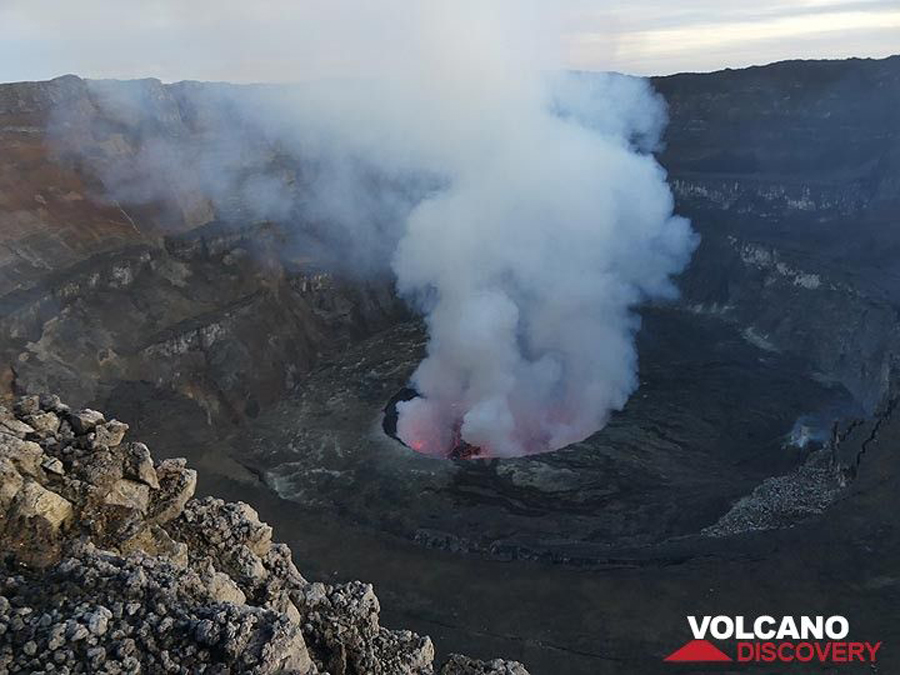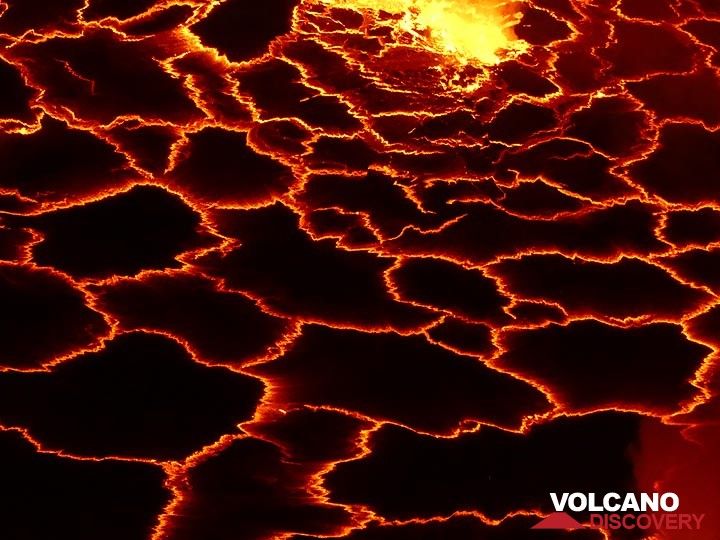Report on Nyiragongo (DR Congo) — November 2017
Bulletin of the Global Volcanism Network, vol. 42, no. 11 (November 2017)
Managing Editor: Edward Venzke.
Research and preparation by Paul Berger.
Nyiragongo (DR Congo) Lava lake persists through October 2017
Please cite this report as:
Global Volcanism Program, 2017. Report on Nyiragongo (DR Congo) (Venzke, E., ed.). Bulletin of the Global Volcanism Network, 42:11. Smithsonian Institution. https://doi.org/10.5479/si.GVP.BGVN201711-223030
Nyiragongo
DR Congo
1.52°S, 29.25°E; summit elev. 3470 m
All times are local (unless otherwise noted)
The lava lake in Nyiragongo's main crater has been observed since 1971, and might have been present even before then. There is no regular ground monitoring of the volcano, but occasional field visits by scientific teams and tourist expeditions provide some information about its activity. Two teams of scientists that visited the volcano during March 2016 provided observations of a new vent (BGVN 42:01). This report describes activity during January-October 2017.
Volcano Discovery reported that on 6 June 2017 a team visited the summit (figure 62) and stayed for three days. They noted that the surface of the lava lake (about 220 m across was continuously in motion as exploding gas bubbles created small degassing fountains that recycled the cold black crust back into the incandescent liquid lava. Strong degassing also occurred from the edges of the lava lake, the 2016 hornito, and along the southern fracture zone.
 |
Figure 62. Photo of the summit caldera at Nyiragongo showing its terraces and lava lake in early June 2016. Courtesy of Ingrid Smet. |
According to a news account (Metro) that cited a statement issued by the Goma Volcanic Observatory, Nyiragongo and nearby Nyamulagira volcanoes experienced intense seismic activity in their respective craters around 17-18 October 2017, before decreasing. Consistent with the presence of the active lava lake, thermal anomalies in satellite-based MODIS data identified by the MODVOLC and MIROVA systems were recorded almost daily during the reporting period.
Geological Summary. The Nyiragongo stratovolcano contained a lava lake in its deep summit crater that was active for half a century before draining catastrophically through its outer flanks in 1977. The steep slopes contrast to the low profile of its neighboring shield volcano, Nyamuragira. Benches in the steep-walled, 1.2-km-wide summit crater mark levels of former lava lakes, which have been observed since the late-19th century. Two older stratovolcanoes, Baruta and Shaheru, are partially overlapped by Nyiragongo on the north and south. About 100 cones are located primarily along radial fissures south of Shaheru, east of the summit, and along a NE-SW zone extending as far as Lake Kivu. Many cones are buried by voluminous lava flows that extend long distances down the flanks, which is characterized by the eruption of foiditic rocks. The extremely fluid 1977 lava flows caused many fatalities, as did lava flows that inundated portions of the major city of Goma in January 2002.
Information Contacts: Tom Pfeiffer, Volcano Discovery (URL: http://www.volcanodiscovery.com/); Observatoire Volcanologique de Goma (OVG), Goma, North Kivu, DR Congo (URL: https://www.facebook.com/Observatoire-Volcanologique-de-Goma-OVG-180016145663568/); Hawai'i Institute of Geophysics and Planetology (HIGP) - MODVOLC Thermal Alerts System, School of Ocean and Earth Science and Technology (SOEST), Univ. of Hawai'i, 2525 Correa Road, Honolulu, HI 96822, USA (URL: http://modis.higp.hawaii.edu/); MIROVA (Middle InfraRed Observation of Volcanic Activity), a collaborative project between the Universities of Turin and Florence (Italy) supported by the Centre for Volcanic Risk of the Italian Civil Protection Department (URL: http://www.mirovaweb.it/); Metro, Mass Transit Media, Gallery Ravenstein 4, 1000 Brussels, Belgium (URL: https://fr.metrotime.be/).


